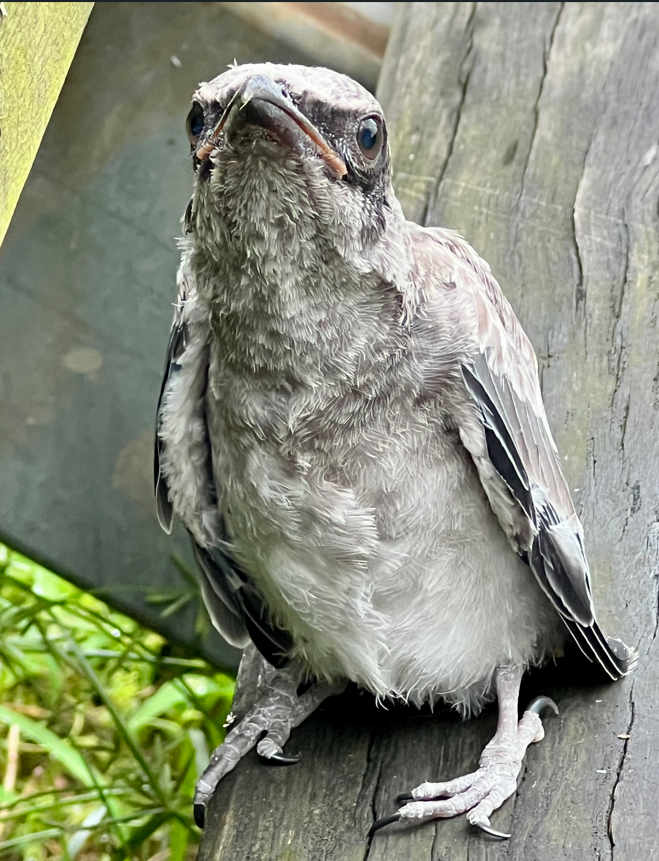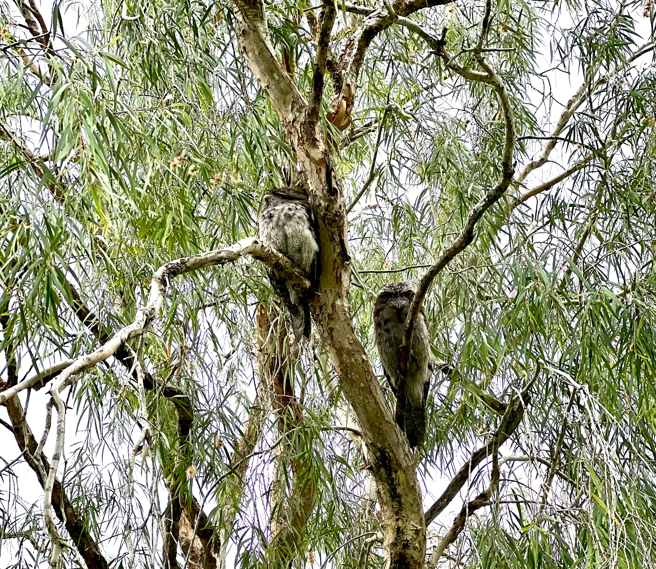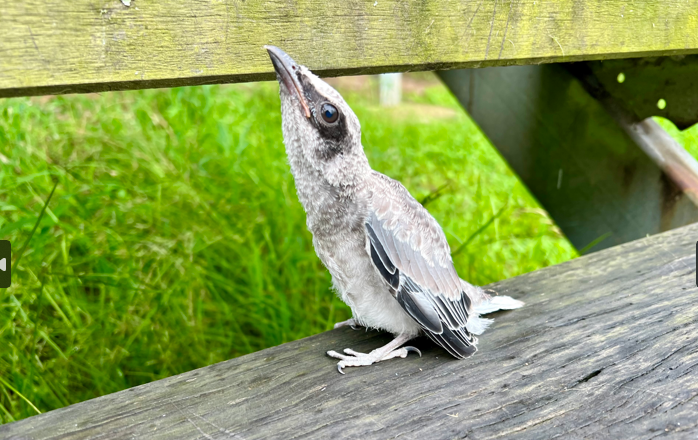
Susanna Freymark
I’ve made a huge mix-up with my chicks. A bird I thought was a tawny frogmouth is a black faced cuckoo shrike.
It was the eyes that got me. I swear that bird was staring right at me like a frogmouth. But this is not a frogmouth.
Thankfully, Sam Munro and Sue Higginson pointed out my mistake when I published the story.
The pair of birds in the tree in my front garden are tawny frogmouths. But this is not their baby.
And from what I’ve read about tawny frogmouths they are unlikely to welcome this feathery stranger in their midst.
Sorry readers, sorry baby bird.
I’ve taken the shrike back out of the tree and will keep it safely contained until morning. I’ve been advised that the mother will come looking for it.
Next time, I’ll send a photo of the chick to WIRES to confirm what it is.
Be smarter than me – know your birds.

Original story
I don’t know a lot about the pair of tawny frogmouths who have lived in the scrubby bark tree in the front garden of my home. They’ve been here in Mallanganee longer than I have.
They tolerate my presence as we stare back at each other. My veranda is up high so I can peer straight into the branches of their tree home.
They do that evil stare frogmouths are known for.
This morning, a chick was on the wet grass. I thought it was a piece of rubbish, until on closer inspection, I saw it was a baby bird.
That stare – I knew who it belonged to immediately.
The chick did not seem injured or distressed.
I left to go on a job. When I returned about four hours later, it was on the front steps its head titled upwards as if looking for its home.
It wasn’t crying and seemed unperturbed by my closeness.
I was worried with night coming and possible predators. The parents were looking down but nothing was happening – no communication, nothing.
I called WIRES and was told to collect the chick in a box using a towel so I didn’t touch it.
About five minutes later, a bird carer from Goonellabah called.
She told me there had been a lot of fledging chicks, not quite ready to fly, who were stranded on the ground.
Because frogmouths are nocturnal, she told me to wait until dark and then put the chick on a flat-ish branch close to the trunk. The parents would do what they needed to under cover of darkness.
I’m waiting for nightfall, the chick is asleep in its temporary container home, until my neighbour comes with a tall ladder.
Then we will relocate the chick as instructed by WIRES.
Wish me and this little hapless staring chick luck – so we both make it back home.
If you need WIRES they are on 1300 094 737.
WIRES needs you too – to donate or train to be a wildlife carer. Go to their Facebook page for more information.
In my quick research I learned five things about tawny frogmouths from National Geographic.
They spray predators with their faeces
Of course, tawny frogmouths are known for their very effective camouflage but if a predator persists it can get messy. The frogmouths first response is to mob, using their beaks to peck at nest intruders. If this fails, the tawny will then spray the predator with their faeces.
They mate for life
Promiscuity for the sake of increasing breeding success just isn’t for frogmouths. Instead, they tend to choose a partner for life. The male tawny frogmouth is fiercely territorial and protective of their nests and will often drive off any male who tries to intrude. These frogmouth pairs are so close that they evict their offspring and spend the rest of their lives close together, perching on trees, leaning against and grooming each other.
They’re well-adapted to Australia’s unpredictable weather
Tawny frogmouths are so well-insulated by their feathers that neither the cold, nor the heat has much of an effect on them.
The tawny won’t show notable signs of heat distress even as the temperature soars to more than 30 degrees.
Rather than opening their beak for better ventilation, the tawny can triple their breathing rate with their beaks closed and produce a type of mucus in their mouths that helps to cool the air as they inhale, which then cools their body.
When the weather is colder, the tawny is one of the only large birds, who go through small bouts of torpor — a type of winter hibernation — to cope with the loss of heat and energy.
They’ve been known to “cry”
The tawny uses a number of different calls to express everything from fear to annoyance. The bird even has a “whimpering call”.
The sound is described as “gut-wrenching” and similar to the “low whimper of a newly born baby in serious pain” this particular call can go on for an entire night.
The whimpering call has also been observed in birds that are about to leave the nest and birds that have been newly orphaned.
They’re terrible at building strong nests
Master nests builders, tawny frogmouths are not. The male tawny will often pick up a few sticks and some leaves and dump them into place; no arrangement and nothing to secure anything in place.
In some cases, tawny frogmouths will just hijack the abandoned nests of different birds. Some research has suggested that because tawny frogmouth nests aren’t secure, chicks will often fall or the parent will accidentally kick an egg out of the tree while trying to get comfy.
It’s possible that this lack of skill when it comes to nest-building is because tawny frogmouths have relied on the sturdy, large branches of flaky-barked eucalypts trees, few of which exist in large numbers today.



